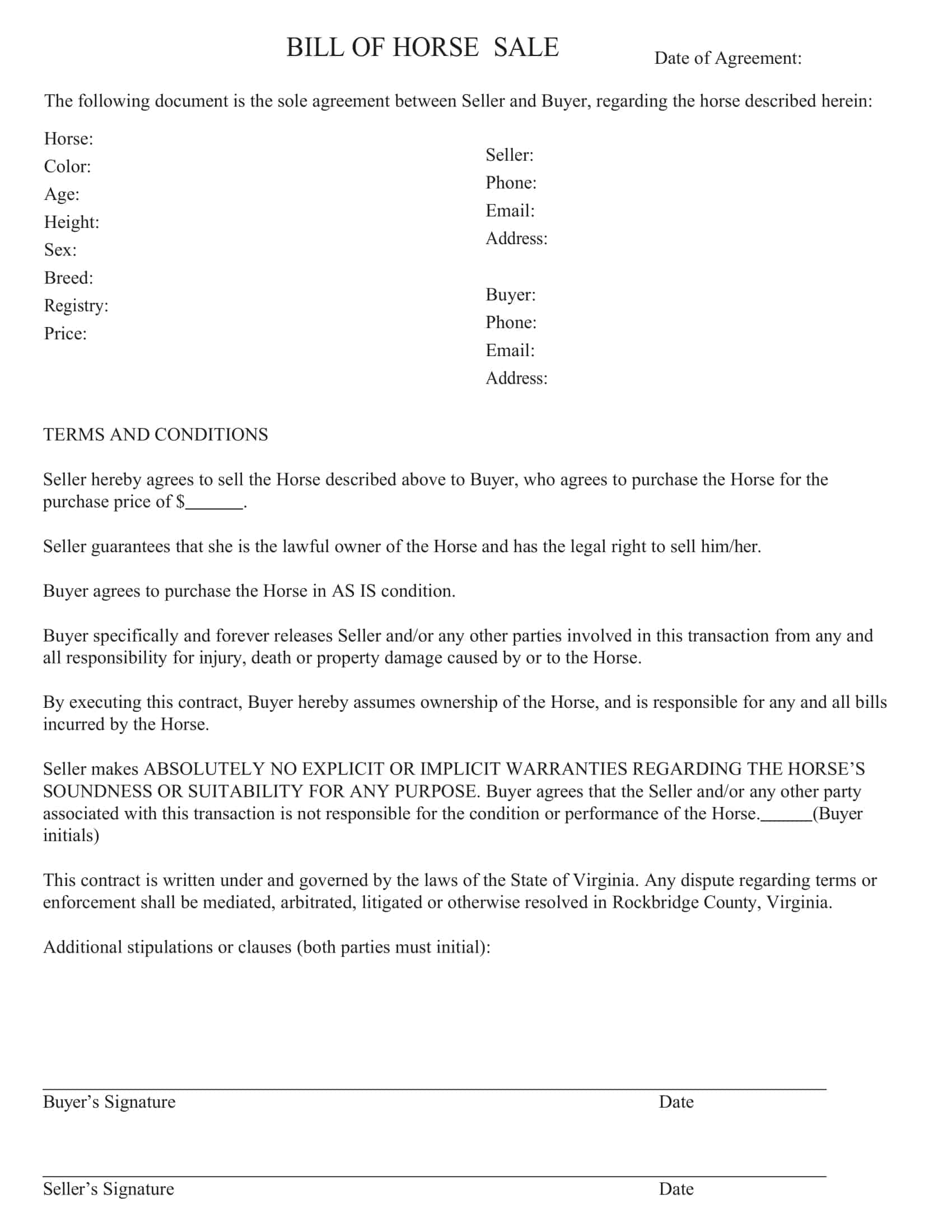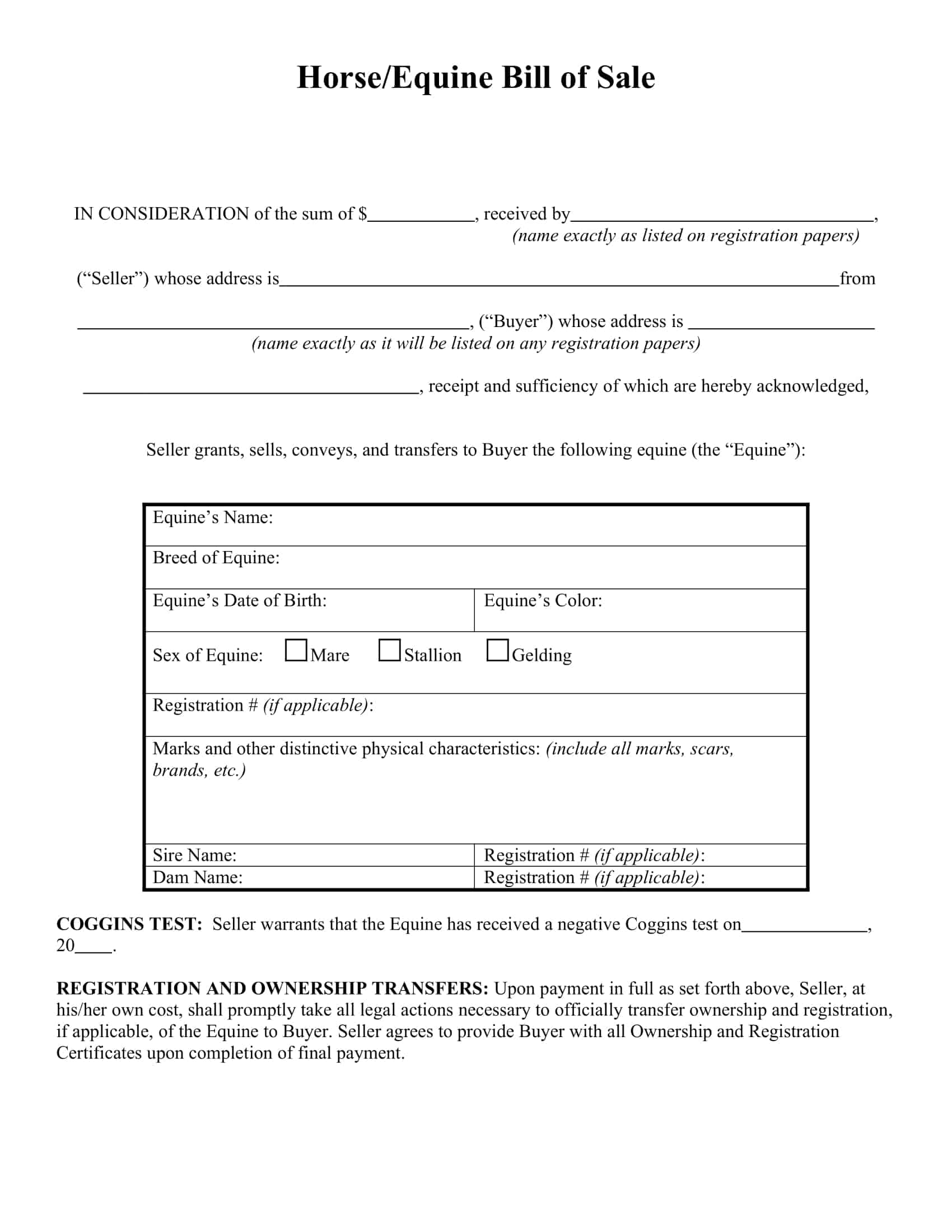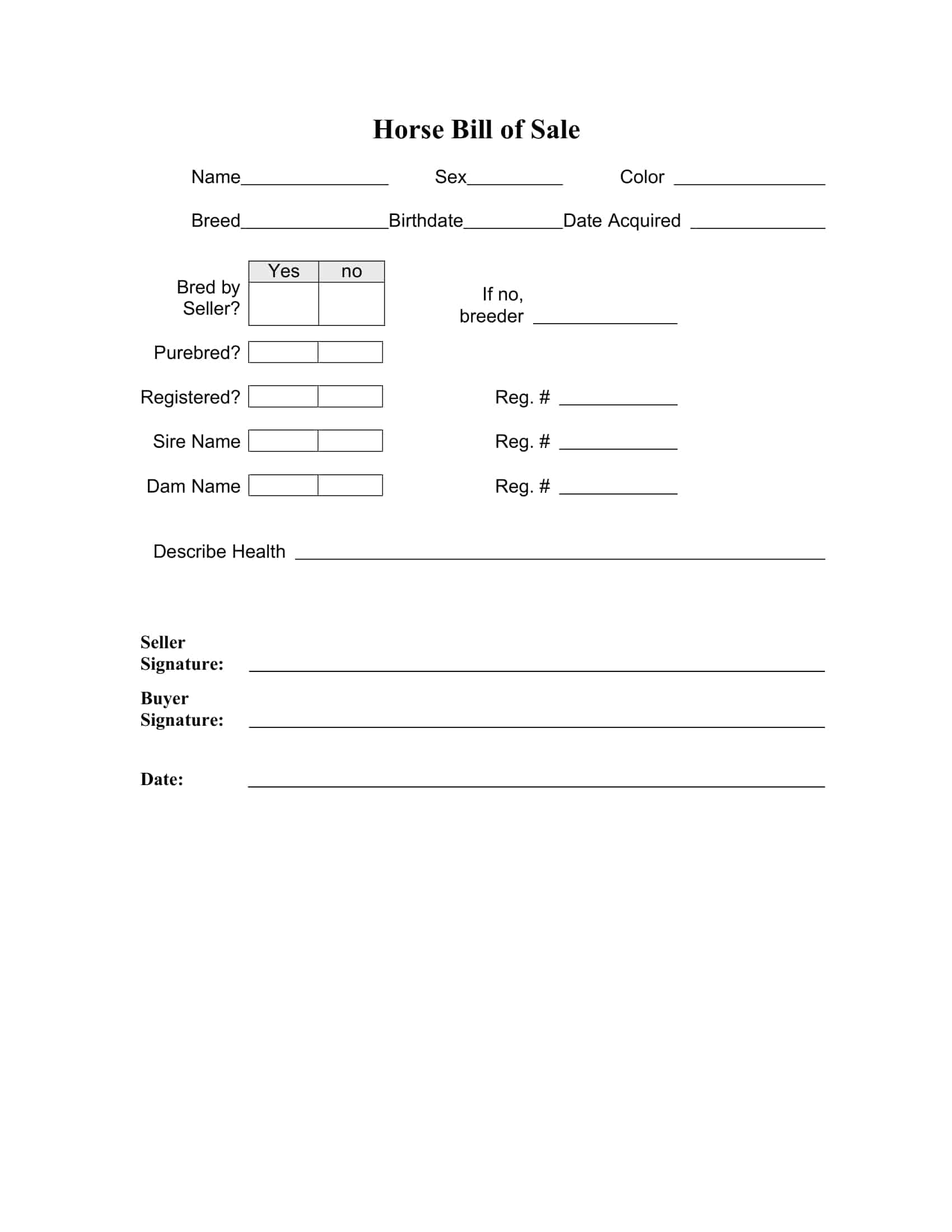A horse bill of sale is a legal document that serves as proof of the transfer of ownership of a horse from the seller to the buyer. It is an important document that should be prepared and executed carefully, as it lays out the terms and conditions of the sale, including the price and any warranties or representations made by the seller.
The bill of sale should be signed by both the buyer and the seller and a copy should be kept by both parties for their records. In this article, we will discuss the key elements of a horse bill of sale and provide a sample document for reference.
Table of Contents
Horse Bill of Sale Templates
Buy or sell a horse with confidence using our comprehensive collection of free printable Horse Bill of Sale templates. These templates provide a legally binding agreement between the buyer and seller, ensuring a smooth and transparent transaction. Customize the templates to include crucial details such as the horse’s information, purchase price, payment terms, warranties, and any additional terms and conditions. Whether you’re a horse owner looking to sell or a buyer in search of your dream horse, our templates offer a clear and professional format to document the sale and protect the interests of both parties. Download now and streamline the process of buying or selling a horse with our convenient and customizable Horse Bill of Sale templates.
Key Elements of Horse Bill of Sale

A horse bill of sale should include the following key elements:
Date of sale: This is the date on which the sale of the horse is being completed.
Names and contact information of the buyer and seller: This should include the full legal names and addresses of both parties, as well as their phone numbers and email addresses.
Description of the horse: This should include the horse’s name, breed, age, gender, color, and any identifying marks or tattoos. It should also include any relevant information about the horse’s health or condition.
Purchase price: The purchase price should be clearly stated in the bill of sale and should be agreed upon by both the buyer and the seller.
Any warranties or representations: The seller should disclose any known issues or defects with the horse and any warranties or guarantees they are providing.
Signature of both parties: The bill of sale should be signed by both the buyer and the seller to indicate their agreement to the terms of the sale.
Why is it important to have a Bill of Sale when purchasing or selling a horse?
A Bill of Sale is important when purchasing or selling a horse because it serves as a legal record of the transaction. It establishes the transfer of ownership from the seller to the buyer, and includes important information such as the horse’s name, breed, age, and any identifying marks, as well as the names and addresses of both the seller and the buyer.
Additionally, it may also include details of the sale, such as the purchase price, date of sale, and any warranties or guarantees. Having a Bill of Sale can help protect both the buyer and the seller in case of any disputes or legal issues that may arise in the future, such as a prior claim of ownership or a breach of contract. It also can act as a proof of ownership if in the future you need to prove it.
How to Write a Horse Sale Contract
Writing a bill of sale for a horse is a straightforward process that can be completed in a few simple steps.
Step 1: Gather the necessary information
Before you begin writing the bill of sale, you’ll need to gather some important information about the horse, the buyer, and the seller. This includes:
- The horse’s name, breed, age, and any identifying marks or tattoos
- The buyer’s name and address
- The seller’s name and address
- The purchase price of the horse
- The date of the sale
- Any warranties or guarantees that come with the sale
Step 2: Write the bill of sale
Once you have all the necessary information, you can begin writing the bill of sale. The document should be written in clear, concise language and should include the following elements:
- A statement of the horse’s name, breed, age, and identifying marks
- A statement of the buyer’s name and address
- A statement of the seller’s name and address
- The purchase price of the horse
- The date of the sale
- Any warranties or guarantees that come with the sale
- A statement that the horse is being sold “as is” or a statement of the horse’s condition, if it is known
- A statement that the horse is free from any liens or encumbrances
- A statement that the seller is the lawful owner of the horse and has the legal right to sell it
- A statement that the buyer agrees to take full responsibility for the horse after the sale
- A statement that the buyer agrees to pay the purchase price in full and on the agreed upon date
- The signature of the seller and the buyer
- The date the contract was signed.
It’s also recommended to include any other information that could be considered important for the transaction, such as veterinary reports or any other relevant documents.
Here’s an example of a simple bill of sale for a horse:
Horse Bill of Sale
This bill of sale, made and entered into on the date of ____________, by and between ____________ (hereinafter referred to as “Seller”) and ____________ (hereinafter referred to as “Buyer”),
WITNESSETH:
That the Seller, for and in consideration of the sum of ____________ dollars ($____________), in hand paid, the receipt whereof is hereby acknowledged, does hereby sell, transfer and deliver to the Buyer, the following described horse:
Name:
Breed:
Age:
Color:
Markings:
The horse is sold “as is” with no warranties or guarantees. The horse is free from any liens or encumbrances. The Seller is the lawful owner of the horse and has the legal right to sell it.
The Buyer agrees to take full responsibility for the horse after the sale and to pay the purchase price in full on the date of ……
IN WITNESS WHEREOF, the parties have executed this Horse Bill of Sale on the date first above written.
Seller:
Buyer:
How to buy a horse?
Purchasing a horse can be a big investment, and it’s important to do your research and take your time to ensure that you find the right horse for you. Here are some steps you can take when buying a horse:
Step 1: Determine your needs
Before you start looking for a horse, it’s important to determine what your needs are. Think about what you’ll be using the horse for (e.g. riding, showing, breeding), what level of rider you are, and what your budget is.
Step 2: Research different breeds and types of horses
Once you know what you’re looking for, start researching different breeds and types of horses. Look into their characteristics, personality, and suitability for your intended use.
Step 3: Find reputable sellers
Look for reputable breeders, trainers, and sellers who have a good reputation and can provide references. Avoid buying a horse sight unseen or from an unknown source.
Step 4: Schedule visits and tryouts
Once you’ve found a horse that you’re interested in, schedule a visit to see the horse in person. Bring a knowledgeable friend or trainer with you and try the horse out to see if it’s a good fit for you.
Step 5: Get a veterinary examination
Before you finalize the purchase, have the horse vetted by a veterinarian. This will give you an idea of the horse’s overall health and any potential issues that may arise in the future.
Step 6: Review and sign the bill of sale and other paperwork
Once you’re satisfied with the horse’s condition and you’ve agreed on a purchase price, review and sign the bill of sale and any other necessary paperwork. Make sure to keep a copy of all the documents for your records.
Step 7: Arrange for transportation
Make arrangements for the horse to be transported to its new home.
Step 8: Provide the horse with proper care and training
After purchasing a horse, it’s important to provide it with proper care and training to ensure that it stays healthy and happy.
FAQs
Is a horse bill of sale required by law?
While a horse bill of sale is not always legally required, it is highly recommended as it establishes the transfer of ownership and serves as a legal record of the transaction. Laws vary state by state, but it is best to check with local authorities to ensure compliance with local laws and regulations.
Can a horse bill of sale be completed online or does it need to be done in person?
A horse bill of sale can be completed online, but it is important that both the buyer and the seller sign the document in order for it to be legally binding. Depending on the state, electronic signatures may be accepted, otherwise it is best to have the bill of sale signed in person.
What should be done if there is a mistake on the horse bill of sale?
If there is a mistake on the horse bill of sale, both the buyer and the seller should agree on the correction and have it added to the bill of sale. Both parties should then initial and date the correction.
Is it necessary to notarize a horse bill of sale?
Notarization of a horse bill of sale is not always necessary, but it can provide added legal protection and security. It is best to check with local authorities to ensure compliance with local laws and regulations.
Can a horse bill of sale be cancelled or voided after it has been signed?
A horse bill of sale can be cancelled or voided under certain circumstances, such as if the horse is found to have a serious health condition that was not disclosed prior to sale, or if the seller breaches any terms or warranties outlined in the bill of sale. In these cases, it is best to consult with a lawyer to determine the best course of action. Additionally, both the buyer and seller should have the agreement of cancelling or voiding the bill of sale, and this should be done in writing and signed by both parties.










































![Free Printable Roommate Agreement Templates [Word, PDF] 1 Roommate Agreement](https://www.typecalendar.com/wp-content/uploads/2023/06/Roommate-Agreement-150x150.jpg)
![Free Printable Credit Card Authorization Form Templates [PDF, Word, Excel] 2 Credit Card Authorization Form](https://www.typecalendar.com/wp-content/uploads/2023/06/Credit-Card-Authorization-Form-150x150.jpg)
![Free Printable Stock Ledger Templates [Excel,PDF, Word] 3 Stock Ledger](https://www.typecalendar.com/wp-content/uploads/2023/08/Stock-Ledger-150x150.jpg)
